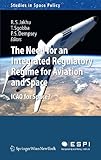The Need for an Integrated Regulatory Regime for Aviation and Space : ICAO for Space? / edited by Ram S. Jakhu, Tommaso Sgobba, Paul Stephen Dempsey.
Tipo de material: TextoSeries Studies in Space Policy ; 7Editor: Vienna : Springer Vienna : Imprint: Springer, 2011Descripción: xxiv, 188 páginas recurso en líneaTipo de contenido:
TextoSeries Studies in Space Policy ; 7Editor: Vienna : Springer Vienna : Imprint: Springer, 2011Descripción: xxiv, 188 páginas recurso en líneaTipo de contenido: - texto
- computadora
- recurso en línea
- 9783709107188
- KZA1002-5205
Springer eBooks
Acknowledgements -- foreword,- about the editors -- executive summary -- list of acronyms -- list of exhibits -- introduction -- chapter 1: background -- chapter 2: legal and regulatory regimes -- chapter 3: safety issues -- chapter 4: need for international space safety regulations -- chapter 5: proposal for a new regulatory regime -- appendix a -- appendix b -- appendix c.
In the new space age after the end of the Cold War, orbit and frequency allocations, traffic control, safety, and a number of support services such as space weather forecast and orbital debris monitoring need to be coordinated transparently and effectively by clear rules at an international level. The establishment of an international civil space regulatory framework is the central theme of this book, in particular, the possible extension to space of the international regulatory framework model adopted for aviation more than 60 years ago with the establishment of the International Civil Aviation Organization (ICAO). The book also highlights the increased reliance of aviation safety on space-based navigation and communication systems, the increasing space systems traffic through the international airspace under the jurisdiction of the ICAO, and the emerging hybrid systems such as aero-spacecraft and space planes, to advocate the practical benefits of directly expanding the ICAO Convention domain beyond the airspace to include outer space up to the geosynchronous orbit.
Para consulta fuera de la UANL se requiere clave de acceso remoto.


